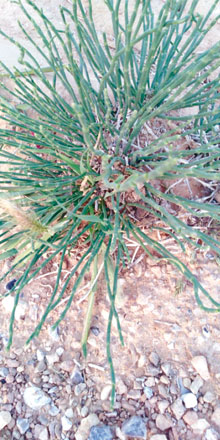AMMAN — Life in a harsh desert faces many obstacles and they are related to food, water and medicine, a Jordanian scholar said, adding that bedouins as nomads move from one place to another searching for water and grazing for their flocks.
“Such a lifestyle kept them away from major towns and they had to sort out their daily life issues,” said professor Fawzi Abudanah from Al Hussein Bin Talal University.
Dealing with severe heat, bedouins applied inherited skills and innovated new ones, he said, adding that he himself experienced this aspect when he was a child.
In order to prepare cheese, bedouins used mesah (a part of the stomach of a young lamb), the archaeologist explained, noting that once mesah is removed, it is then dried with salt.
“After it gets completely dried up, a small part of it is taken and wrapped in clean sheep wool or a piece of textile. It is then put into a bowl of milk using the fingers for a few minutes. The milk will start coagulated afterwards,” Abudanah said.
Preservation of meat is another problem that bedouins solve by inserting cooked parts into a large textile bag which is used for keeping jamid, he said, adding that high concentration of salt in the bag and relatively cold temperature of jamid can protect meat from rotting for few days.
For water cooling, the bedouins use an animal skin (goat or sheep), called qirbah, which is well cleaned first and then tanned, he said.
“Leather tanning is common among the bedouins in southern Jordan. They get the necessary material for this process from the oak trees at Al Hisheh Forest [northeast Petra],” the professor said.
To wash their hair, the bedouins use the shrub called the adhuo or the shnan (Anabasis Syriaca) as a soap to wash their hair and the hair would become blond if the washing process is repeated, Abudanah underlined.
“The shrub is first fired and its ash is then collected and soaked in a pail of water. The liquid is then used for hair washing,” the scholar noted.
“Purifying drinking water is essential for survival, so the bedouins purify the water they get from depressions or springs by using flour or alum: A small amount of flour or alum is added to the water in a large vessel and after a while all the impurities and sands would sink at the bottom of the vessel.”
Another shrub called barnooq is used as a colour fixative when they dye the wool of sheep to produce a rug by weaving, he said, noting that the shrub is added to the container that is used to dye the wool.
“It is part of my heritage and culture, and am very well aware of all the examples I have shown in my presentation although most of hacks that the scholar studied are no more in use due to the social progress and the use of modern tools and materials.”
